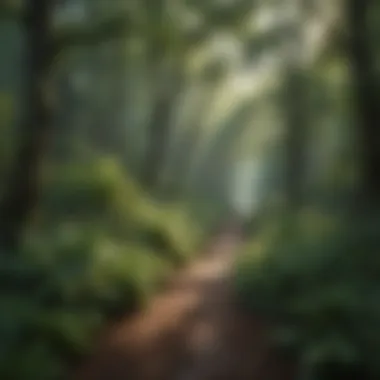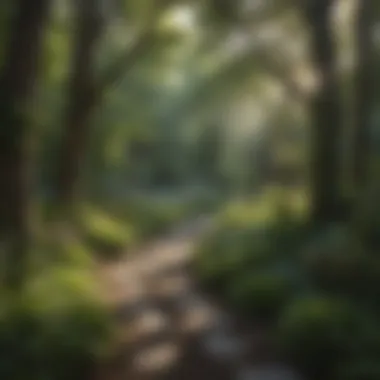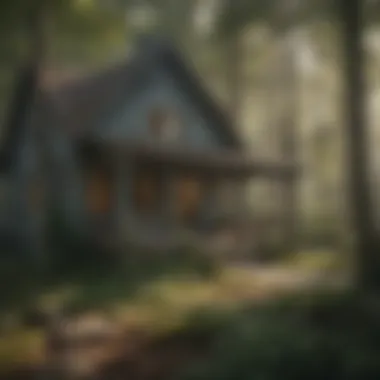Behr Grey Seas: Color Psychology in Woodland Design


Intro
The exploration of color psychology often leads us to consider how shades influence our emotions and behavior. In the context of woodland design, the significance of color extends beyond mere aesthetics. Behr Grey Seas, a captivating grey tone, exemplifies how colors can create tranquility and establish a connection with nature. This article will investigate the implications of this color in woodland ecosystems, its integration within sustainable forestry practices, and the stewardship techniques that enhance ecological interaction through design.
Understanding these elements is crucial for forestry professionals and academics who seek to create harmonious environments. The blend of aesthetics and ecological values invites a deeper appreciation of nature, enhancing our outdoor spaces for both humans and wildlife.
Understanding Woodland Ecosystems
Importance of Biodiversity in Forests
Woodland ecosystems are rich tapestries of life, teeming with numerous species of plants, animals, and microorganisms. Biodiversity plays a crucial role in maintaining the health of these environments. Diverse species contribute to ecosystem resilience, enabling it to withstand disturbances such as climate change and habitat loss.
By promoting a variety of flora and fauna, we ensure that the ecological processes needed for sustaining life in forests continue unhindered. This is particularly relevant when considering the application of colors like Behr Grey Seas, which can influence perceptions of beauty and health in these ecosystems.
Role of Forests in Climate Regulation
Forests play an indispensable role in climate regulation. They sequester carbon dioxide, helping to mitigate climate change effects. Additionally, they contribute to local humid climates, influence precipitation patterns, and maintain water cycles.
The design of woodland areas often incorporates colors that reflect their natural surroundings. Grey tones like Behr Grey Seas can seamlessly integrate into this palette, evoking a sense of calm that promotes awareness of the ecological importance of these spaces. A well-designed woodland can encourage sustainable practices and foster an appreciation for biodiversity.
Sustainable Forestry Practices
Principles of Sustainable Forestry
Sustainability in forestry revolves around practices that balance economic, social, and environmental needs. Some core principles of sustainable forestry include:
- Maintaining forest health to promote biodiversity.
- Promoting the use of native species to support local wildlife.
- Implementing responsible harvesting techniques to prevent overexploitation.
Behr Grey Seas can serve as a color choice in projects targeting sustainable goals, helping designers communicate their commitment to ecological responsibility.
Case Studies of Successful Implementations
Examining case studies of successful woodland designs can provide insights into effective practices. For instance, projects that incorporate natural shades into their planning often see enhanced community engagement and ecological benefits. Designs that use grey tones can blend with the forest, encouraging thoughtful reflection and interaction within these environments.
Woodland Stewardship Techniques
Forest Management Plans
Effective forest management plans are essential for sustaining woodland health. These plans should outline clear objectives, including:
- Monitoring biodiversity levels and assessing ecosystem health.
- Implementing soil conservation measures to protect against erosion.
- Enhancing recreational opportunities while ensuring minimal ecological disturbance.
By integrating shades like Behr Grey Seas into the design of information centers or signage within these woods, managers can foster a greater understanding of ecological values among visitors.
Conservation Strategies
Conservation strategies focus on protecting existing resources while promoting restoration and rehabilitation of degraded areas. Effective strategies include:
- Creating protected areas to preserve biodiversity.
- Engaging local communities in conservation efforts.
- Utilizing education and outreach to raise awareness around conservation issues.
Incorporating Behr Grey Seas in educational materials and signage can reinforce the tranquil beauty of nature and enhance community commitment to preservation efforts.
The interplay between color and environmental awareness can be pivotal for fostering stewardship in woodland ecosystems.
Prelims to Behr Grey Seas
Behr Grey Seas has been a subject of interest in various design disciplines, particularly in woodland design. Understanding its importance involves recognizing its capacity to influence aesthetic choices as well as emotional experiences. As a muted yet complex shade of grey, Behr Grey Seas conveys a sense of calmness and neutrality. Designers and forestry professionals often utilize this color to create harmonized spaces that foster a connection to nature. The context of this color encompasses not just aesthetics but also psychological impacts, which can enhance the overall environment of woodland areas.
Defining Behr Grey Seas


Behr Grey Seas is more than just a paint color; it embodies a concept that may bridge the gap between rustic natural landscapes and contemporary design. This color tends to reflect the subtleties of the natural world—think of the fog rolling over the forest floor, or the slight greyness of tree bark. By defining Behr Grey Seas, one highlights its attributes such as its cool undertones and versatility in various settings. It serves well in both outdoor and indoor applications, allowing architects and designers to maintain a cohesive look throughout a project. Additionally, this color is able to blend well with other natural hues found in woodlands, such as earthy greens and rich browns, reinforcing the connection between designed spaces and their natural surroundings.
Historical Context of Grey Tones
The use of grey tones in design has a rich history that extends across cultures and eras. Historically, grey was seen as a practical choice—an adaptive color that absorbed light in less than ideal conditions while still maintaining a stylish façade. In the context of woodland design, grey tones like Behr Grey Seas accentuate the myriad shades found in nature. Indigenous practices often included grey tones to provide balance and harmony, signaling respect toward the environment. This historical backdrop illustrates how grey tones are not simply aesthetic but hold cultural significance, affecting not only visual aspects but also emotional responses to spaces. This interplay makes Behr Grey Seas particularly relevant today, as its understanding can lead to more effective designs that celebrate both nature and structure.
The Psychology of Color
The exploration of color psychology serves as a crucial pillar in understanding how colors impact human emotions and behaviors. In the context of woodland design, colors guide not only aesthetics but also define the emotional experience of those spaces. Behr Grey Seas, with its muted tone, invites a sense of calmness and balance, making it an ideal choice for environments aiming to foster tranquility. By tapping into color psychology, designers can create spaces that resonate positively with individuals and enhance their connection to nature.
Understanding Color Perception
Color perception is a multifaceted process that involves physiological and psychological components. Humans perceive color through light waves, which are interpreted by the brain. This interaction is not purely biological; cultural and personal experiences play significant roles in how individuals interpret colors. For instance, while grey may signify neutrality in many cultures, others may associate it with gloom. Recognizing these nuances is essential when utilizing shades like Behr Grey Seas in design, as the intended message can vary significantly across different audiences.
When applying color in woodland settings, one must consider environmental factors as well. Natural light, surrounding vegetation, and even seasonal changes influence how colors appear. Behr Grey Seas can shift its essence based on these conditions, requiring designers to be vigilant and intentional in their applications.
Grey and Human Emotion
Grey holds unique emotional significance. It often embodies a sense of balance, wisdom, and contemplation. In design, it’s important to recognize how grey can affect mood and perception. Unlike more vibrant colors, grey does not demand attention. Instead, it encourages introspection and peace. This makes Behr Grey Seas particularly appealing in spaces where one wants to promote relaxation and mindfulness.
Several studies indicate that colors can evoke specific emotional responses. Grey, often seen as a neutral ground, allows other colors within a design to shine without overwhelming the observer. Its adaptability enables it to pair harmoniously with natural materials, enhancing the overall sensory experience.
"Color is a power which directly influences the soul." – Wassily Kandinsky
In woodland design, using Behr Grey Seas can help create an environment that soothes and invites reflection. It can act as an ideal backdrop for both personal spaces and shared public environments, facilitating connection to nature and oneself.
Understanding the emotional depth of grey aids in crafting designs that not only look appealing but also resonate profoundly with individuals, inviting them into a space that is both beautiful and purposeful.
Application of Behr Grey Seas in Design
The application of Behr Grey Seas in design holds significant importance in creating environments that blend aesthetic pleasure and ecological introspection. Grey tones, particularly Behr Grey Seas, are often perceived as neutral, allowing them to serve as a backdrop that enhances surrounding elements. This balance is not only visually appealing but essential in promoting a sense of tranquillity within woodland contexts. Designers and landscapers often seek grey because it mimics natural stone and weathered wood, which are typical in forested areas, thus creating harmony with the environment.
When considering the integration of Behr Grey Seas, one must recognize its versatility. Benefits include:
- Compatibility: This shade pairs effortlessly with a variety of colors and materials found in nature, such as greens and browns.
- Calmness: Incorporating this color can contribute to a peaceful atmosphere, promoting relaxation and contemplation, crucial for woodland spaces.
- Timelessness: Grey remains contemporary, ensuring designs won’t quickly become outdated.
While selecting this color, several considerations must be made. Understanding the environment where Behr Grey Seas will be implemented ensures its effective incorporation. For instance, the impact of sunlight on the color's appearance should be evaluated, as shadows and light can alter how the shade is perceived throughout the day. A detailed assessment of existing flora is necessary; grey tones can either complement or clash with the foliage depending on the surrounding hues.
Landscape Aesthetics
In landscape aesthetics, Behr Grey Seas plays a pivotal role in shaping outdoor spaces that resonate with nature. The subtlety of this color allows it to act as a canvas upon which more vibrant colors can be layered. This approach highlights foliage and floral arrangements to stand out sharply against the muted yet warm undertones of grey.
When used in landscape design, Behr Grey Seas can:
- Enhance natural features: Grey can underline the textures of bark, leaves, and rocks, educating observers about the diverse beauty embedded in nature.
- Create focal points: By utilizing hardscapes or structures painted in Behr Grey Seas, one can guide the gaze toward natural elements, such as trees or water bodies.
- Facilitate transitions: The color helps in smoothly transitioning different areas of a landscape, integrating hardscapes and softscapes seamlessly.
Interior Spaces and Woodland Contexts
When applied to interior spaces situated in or around woodlands, Behr Grey Seas fosters a connection with the outdoor landscape. This color invites nature indoors, offering an aesthetic that resonates with the surrounding environment. In designing such spaces, several aspects stand out.
First, natural light’s influence should be considered. Behr Grey Seas can take on different characteristics based on how much light enters the room, creating atmosphere changes throughout the day. This dynamic quality adds layers of experience within the same space.
Moreover, the application of Behr Grey Seas enhances:
- Spatial perception: The use of grey can make spaces look larger and more open, a significant benefit in smaller interiors common in woodland cabins or retreats.
- Earthy elements: Incorporating wooden furnishings or natural textures alongside Behr Grey Seas can create a cohesive theme that feels grounded and organic.
- Softness: Unlike sharper colors, grey introduces a softness that calms the senses while highlighting the rugged beauty of the outside world.
"The integration of Behr Grey Seas in design signifies a departure from mere aesthetics to embodying a philosophy that values both beauty and ecological awareness."
Behr Grey Seas and Ecological Design
The exploration of Behr Grey Seas reveals more than aesthetic appeal; it encompasses profound implications for ecological design. This shade, a soothing yet striking tone, blends seamlessly with natural surroundings, contributing not only to visual beauty but also enhancing the functionality of outdoor and indoor spaces. The significance of such tonalities in ecological design cannot be overstated, as they play a vital role in creating environments that promote sustainability, biodiversity, and emotional well-being.


Sustainable Practices in Color Usage
Sustainable practices in color usage are essential in the context of woodland design. Using Behr Grey Seas can lead to direct benefits in ecological conservation and enhancement. Here are a few considerations regarding color and sustainability:
- Minimized Reflectivity: Grey tones like Behr Grey Seas reduce glare while harmonizing with greenery, facilitating a gentler visual transition between natural and built environments.
- Durability in Material Selection: In choosing materials painted with Behr Grey Seas, one often opts for sustainable resources, which also ensure longevity and an overall reduction in waste.
- Ecosystem Compatibility: Many flora and fauna thrive under subdued colors, thus using hues like Behr Grey Seas in landscape design helps maintain ecological balance.
Furthermore, incorporating natural dyes and sustainable paints aligned with the principle of low environmental impact reinforces the color's role in promoting ecological integrity. The adaptive reuse of grey despite changing trends in design echoes a commitment to conservation, allowing spaces to evolve without destructive practices.
Integrating Color with Functionality
Integrating Behr Grey Seas into design goes beyond aesthetics; it is about enhancing functionality within spaces. This color can be effectively employed to achieve the following:
- Visual Cohesion: Behr Grey Seas serves as a neutral backdrop that enables various design elements to coexist harmoniously, ensuring a balanced visual experience.
- Psychological Resonance: This color offers a calming effect which can reduce stress in various settings, from urban parks to woodland retreats.
- Environmental Adaptation: By using Behr Grey Seas, designers can create spaces that feel linked to their environment, ultimately encouraging inhabitants to connect with nature.
An effective strategy for integrating color with functionality involves thoughtful planning. Designers should assess how colors interact with natural light and surrounding materials. Moreover, it is crucial to keep the ecological footprint minimum while enriching the user experience.
"Color has the power to influence behavior and enhance experiences. In ecological design, it holds significant potential to promote wellness and sustainability."
Cultural and Spiritual Implications of Color in Woodlands
Understanding the cultural and spiritual implications of color in woodlands is crucial for several reasons. First, colors influence human emotion and perception. They shape how we interact with our environment and how we feel within it. Behr Grey Seas, as a grey tone, carries various meanings in different cultures. It can symbolize stability, peace, and a connection to nature. This is particularly useful in woodland settings where themes of tranquility and harmony with the surroundings are desired.
Moreover, the intentional use of color in designing woodlands can enhance spiritual experiences. Many cultures view certain colors as spiritual symbols, deeply intertwined with nature’s elements. Applying these colors thoughtfully aids in creating spaces that resonate with individuals on a deeper level. It can facilitate meditation, reflection, and a sense of community around shared values.
Historical Perspectives on Grey Tones
Historically, grey tones have held significant meanings across diverse cultures. In many societies, grey has been associated with neutrality and balance. Ancient cultures often used grey pigments made from natural materials. These pigments were valued for their ability to blend into the environment, complementing the earthy tones of woods and stones.
In the context of woodland design, the use of grey can symbolize a return to nature. It's a color that does not overpower surroundings but instead merges seamlessly with them. It reflects the understated beauty of woodlands, conveying a sense of sophistication without being imposing. Over time, the perspective on grey has shifted, and it is now often embraced in modern aesthetics for its versatility and calming presence.
Color Significance in Indigenous Practices
Indigenous practices often possess a profound understanding of the natural world, particularly in how colors interact with the environment. For many indigenous cultures, colors are not mere visual elements; they are carriers of stories and traditions. Behr Grey Seas, in this light, can represent the resilience of the natural world. It can also convey the intertwining of land and spirit, serving as a reminder of the depth of ecology and inherent harmony.
Additionally, colors such as grey can imbue specific meanings related to seasonal changes, cultural ceremonies, and spiritual practices. The aesthetic choices made by indigenous communities often reflect a deep respect for the land. The careful application of grey tones in woodland areas can acknowledge and honor these traditions.
It's essential to recognize these cultural dimensions when applying colors in design, especially in woodland settings. Integrating such understanding will enrich the experience for all those who engage with these spaces.
Using color in woodland design is not merely a visual exercise. It is a bridge between culture, history, and humanity's connection to the natural world.
Challenges in Color Implementation
In the realm of woodland design, the implementation of color, particularly tones such as Behr Grey Seas, presents unique challenges that merit careful consideration. Color is more than mere aesthetics; it plays a crucial role in shaping visitor experiences, influencing emotions, and fostering an integrative relationship with the environment. The challenges arise from various factors, including environmental conditions, human perceptions, and ecological integrity.
One significant aspect is understanding how environmental factors impact color perception. Colors appear differently depending on lighting conditions, surrounding textures, and even seasonal changes. This variability can complicate the intended visual message that designers wish to convey. For example, a shade that evokes calmness in daylight may appear stark or cold under artificial lighting. Designers must account for these variances when selecting a color palette, ensuring that hues resonate harmoniously through various conditions.
"Color perception is profoundly influenced by its context and surroundings, making it essential for designers to adapt their choices according to the environment."
Another key consideration is finding the balance between aesthetics and ecological integrity. Colors must be selected not only for their visual appeal but also for their potential ecological impact. For instance, while Behr Grey Seas may enhance the beauty of woodland spaces, it can also affect the behavior of local wildlife or the growth patterns of certain plant species. Color choices should enhance the aesthetic experience while fostering biodiversity and supporting the natural ecosystem.
To navigate these challenges effectively, several strategies can be employed:
- Holistic Design Approach: Incorporating a comprehensive understanding of ecological systems alongside aesthetic values ensures that color choices support both visual and ecological outcomes.
- Flexible Color Schemes: Employing a palette that can adapt to different environmental conditions helps maintain a consistent and effective use of color
- User-Centric Perspectives: Considering the viewpoints of various users can provide insights into how colors are experienced, allowing for more informed design decisions.
The challenges of implementing color in woodland contexts are complex but not insurmountable. By addressing environmental influences and seeking a balance with ecological responsibilities, designers can create spaces that highlight the beauty of nature while promoting sustainability and emotional well-being.
Environmental Factors Influencing Color Perception
In woodland design, environmental factors play a pivotal role in how colors, such as Behr Grey Seas, are perceived. Various elements, such as lighting, surrounding colors, and natural textures contribute to this perception.


- Lighting Conditions: Natural light varies throughout the day, impacting how colors appear. Early morning light casts soft shadows, while midday sun brightens hues. Understanding these variations helps designers choose colors that remain consistent from dawn till dusk.
- Surrounding Colors: Colors do not exist in isolation. The adjacent colors can influence how one perceives a specific shade. For instance, placing Behr Grey Seas next to vibrant greens can enhance its calming effect or may dull its presence if surrounded by darker shades.
- Seasonal Changes: Different seasons yield varying plant life and colors. A color that appears vibrant in spring might look different in the fall when leaves change color. Designers must take these seasonal changes into account to maintain visual integrity year-round.
To effectively bridge these challenges, designers can:
- Conduct color studies within the intended environment to see how Behr Grey Seas interacts with lighting and other colors.
- Use color samples in different locations to understand how the hue shifts with context.
Balancing Aesthetics with Ecological Integrity
Maintaining a delicate balance between aesthetics and ecological integrity is crucial in woodland design. The selection of tones like Behr Grey Seas should enhance the natural beauty of spaces while minimizing ecological disruption.
- Consider Wildlife Impact: Some color choices may alter animal behavior or disrupt habitats. It is crucial to analyze how certain colors might affect local fauna. The goal should be to select colors that not only please human observers but also coexist harmoniously with wildlife habitats.
- Support Native Flora: Choosing colors that complement and enhance native plants can create an aesthetically pleasing environment while simultaneously supporting or promoting local biodiversity. This alignment fosters a connection with nature and emphasizes the ecological aspects of design.
- Mindful Resource Use: The materials used to implement colors should be sustainable. Opting for non-toxic paints and stains aligns with ecological responsibilities and broadens the acceptance of design spaces.
To achieve this balance, practitioners can set guidelines for color use that align with sustainability principles, ensuring that both beauty and ecological integrity are preserved in woodland designs. In doing so, the incorporation of Behr Grey Seas not only enhances visual appeal but plays a vital role in promoting the health of ecological systems.
Case Studies: Successful Uses of Behr Grey Seas
In the exploration of Behr Grey Seas, it becomes essential to examine real-world applications of this color in both landscapes and interiors. Case studies reveal not only the aesthetic power of Behr Grey Seas but also its versatility in design contexts that prioritize ecological integrity and emotional resonance. By analyzing successful uses of this grey tone, we can understand how it contributes to the ambiance and functionality of spaces, especially in woodland environments.
Landscapes Enhanced by Grey Tones
Grey tones, like Behr Grey Seas, are often utilized in landscape design to create a serene backdrop that complements organic elements. The calmness of this hue serves multiple purposes:
- Contrast with Vegetation: Grey tones enhance the vibrancy of surrounding flora. They provide a neutral canvas that makes green hues pop, thus showcasing the richness of plant life.
- Harmonizing with Natural Features: Using Behr Grey Seas helps landscapes to blend with existing natural features. Whether it is stone pathways or wooden decks, this color effectively integrates with various textures, preserving the natural aesthetics without overwhelming them.
- Creating Tranquil Spaces: Landscapes designed with Behr Grey Seas can promote relaxation. This color tends to instill a sense of tranquility, ideal for spaces meant for contemplation or leisure.
Examples of Successful Landscape Applications Includes:
- A nature retreat center that applies Behr Grey Seas on minimalistic picnic tables, providing both functionality and style amongst a lush green setting.
- Urban parks utilizing grey benches and pathways that invite people to engage with the natural surroundings while maintaining a clean and modern look.
Interiors Inspired by Nature
In interior design, Behr Grey Seas is celebrated for its ability to reflect nature indoors. It fosters an environment where occupants feel connected to the outside world. Here are some key benefits and considerations for using Behr Grey Seas in interior spaces:
- Natural Light Reflection: Grey can reflect light effectively, resulting in brighter interiors. When paired with strategically placed windows, Behr Grey Seas enhances the overall ambience of a room.
- Versatile Accompaniment: This grey tone works well with various color schemes. Whether used alongside warm earthy shades or cooler blue undertones, it maintains a balance that is visually pleasing and comforting.
- Facilitating Focus on Nature-Inspired Elements: Behr Grey Seas allows furniture and decor inspired by nature to stand out.
Notable Examples in Interior Design include:
- A cozy woodland cabin where Behr Grey Seas adorns the walls, promoting a warm yet contemporary feel without detracting from the surrounding forest views.
- An eco-conscious office that uses Behr Grey Seas to create a calming workspace, filled with plants and natural wood finishes, fostering productivity while reducing stress.
Ending and Future Directions
The exploration of Behr Grey Seas within the framework of color psychology offers a pathway to understanding not only the aesthetics of woodland design but also its deeper implications. This article illustrates how color choices can significantly influence our interaction with natural environments. As designers and forestry professionals reflect on their work, revisiting color choices encourages a thoughtful approach. Future considerations may include the evolving preferences of individuals for subtle hues that reflect nature’s tranquility.
Color psychology is intertwined with spatial experience and ecological advocacy. This connection invites professionals to think critically about their choices in contexts that encourage sustainable living. The understanding gained through this examination can foster spaces that are not only visually appealing but also harmonize with ecological integrity. The journey towards achieving such balance requires dedication and innovation.
"The aesthetic and ecological are not separate; they are a unified force in design."
Sustainable practices and color knowledge can contribute to this unity by providing frameworks to assess the impact of design decisions on the environment. As resources become scarcer and the urgency to address climate issues increases, revisiting and redefining color choices in woodland design holds both promise and responsibility.
Understanding how specific tones impact human emotion and overall wellbeing can help professionals make informed decisions. Integrating Behr Grey Seas more consciously into both landscapes and interiors can enhance the experience of users while respecting ecological systems. This dual focus on aesthetic sophistication and environmental awareness may shape the future directions of woodland design.
Revisiting Color Choices in Woodland Design
The decision to utilize Behr Grey Seas in woodland design is not an arbitrary choice but reflects an intention to create serene and balanced environments. As designers reconsider their color palettes, it is vital to assess how shades interact with natural elements and human emotions. Grey tones, such as Behr Grey Seas, offer versatility. They can reduce the sensory overload commonly associated with brighter colors, thus promoting feelings of calmness and grounding.
The process of revisiting color choices encourages designers to note:
- Natural Compatibility: Understanding how grey interacts with the surrounding flora. Focus on complementary shades and how they can enhance or dull existing tones.
- Psychological Effects: Recognizing the emotional responses elicited by color when placed within the woodland context.
- Trends and Preferences: Staying informed on contemporary color trends and how shifting preferences can influence future designs.
It's also beneficial to engage with clients and community members to gather insights about what hues resonate with their experiences in nature. This collaborative approach fosters deeper connections and informs better design decisions.
Encouraging Sustainable Practices Through Color Knowledge
Sustainable practices in color utilization go beyond the aesthetic. Understanding the environmental impacts of chosen hues is crucial in woodland design. Integrating Behr Grey Seas into design projects can serve as a model for responsible color use.
Encouraging sustainable practices through color knowledge involves:
- Resource Selection: Choosing paints and materials that adhere to sustainability standards. Look for low-VOC or environmentally friendly options where possible.
- Educational Initiatives: Creating workshops or guidance materials for clients about the impacts of color and the significance of sustainable choices in design.
- Adaptation of Existing Systems: Modified use of existing colors in a way that maximizes their effectiveness without compromising ecological health.







